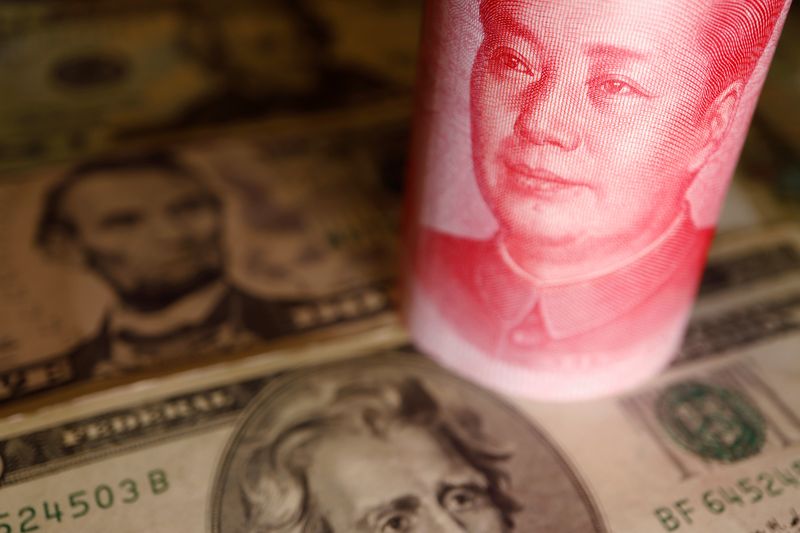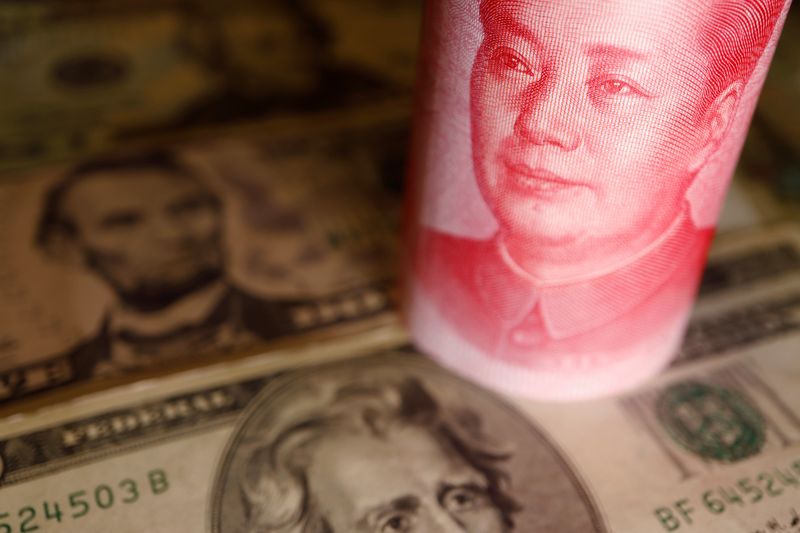Forex
Dollar steady near 6-month high on growth fears, weak yen draws warning


© Reuters. FILE PHOTO: U.S. Dollar and Chinese Yuan banknotes are seen in this illustration picture taken June 14, 2022. REUTERS/Florence Lo/Illustration/File Photo
By Samuel Indyk and Ankur Banerjee
LONDON (Reuters) – The dollar held close to a six-month peak as jitters over China and global growth weighed on risk appetite, while the yen strengthened as Japan’s top currency diplomat sent a warning about the currency after it earlier dropped to a 10-month low.
The yen strengthened by as much as 0.4% to 147.02 per U.S. dollar after Japan’s top currency diplomat, Masato Kanda, said they won’t rule out options if speculative moves persist, the strongest warning since mid-August.
By 1040 GMT, it stood at 147.34 per dollar, compared with 147.82 earlier in the session, which was its lowest since Nov. 4.
The Asian currency has hovered around the key 145-per-dollar level for the past few weeks, leading traders to keep a wary eye on signs of intervention by Tokyo.
Kanda, Japan’s vice-minister of finance for international affairs, has been the central figure in the country’s efforts to stem the sharp decline of the yen since last year.
“The remarks suggest that intervention could be imminent with the yen in the intervention zone we saw last year,” said Chris Turner, ING global head of markets and regional head of research for UK and CEE.
Japan intervened in currency markets 12 months ago when the dollar rose past 145 yen, prompting the Ministry of Finance to buy the yen and push the pair back to around 140 yen.
“I think we’ll probably see intervention but that doesn’t necessarily mean the underlying trend will turn around any time soon,” Turner added, citing the ongoing strength in the U.S. dollar.
Against a basket of currencies, the dollar was at 104.69, not far off the six-month high of 104.90 touched on Tuesday. Economic data from China and Europe on Tuesday fanned some fears of slowing global growth, pushing investors to scramble for the greenback.
“Dollar strength remains the dominant play,” said Christopher Wong, currency strategist at OCBC in Singapore. Higher-for-longer U.S. interest rates and the relative U.S. growth resilience are supporting the greenback, Wong said.
Data from the euro zone and Britain on Tuesday showed a decline in business activity last month, while a private-sector survey showed China’s services activity expanded at the slowest pace in eight months in August.
“There’s been a hangover from soft PMIs particularly in the manufacturing space,” ING’s Turner said.
“The energy story, as we saw last summer, can also really hurt the euro, although it’s not as bad now as it was back then.”
Oil prices settled at a ten-month high on Tuesday as Saudi Arabia and Russia extended supply cuts, although European prices are well below the peaks reached in August last year.
The euro was last up 0.2% at $1.0739 as three influential rate-setters at the European Central Bank warned investors to not rule out a rate hike in September.
Speaking on the last day before the ECB’s self-imposed quiet period before their meeting next week, the heads of the German, French and Dutch central banks’ said the decision was still open.
Traders are pricing in around a one-in-three chance that the central bank raises rates by 25 basis points at the September meeting and a two-in-three chance they keep rates unchanged.
Meanwhile, sterling was last at $1.2549, having touched a three-month low of $1.25285 on Tuesday.
fell to a 10-month low against the dollar on Wednesday before paring some losses as state banks stepped in to offer support.
The Australian dollar rose 0.3% to $0.6398, after diving 1.3% on Tuesday following the weak data from China and as the Reserve Bank of Australia kept rates on hold.

 Forex3 years ago
Forex3 years agoForex Today: the dollar is gaining strength amid gloomy sentiment at the start of the Fed’s week

 Forex3 years ago
Forex3 years agoUnbiased review of Pocket Option broker

 Forex3 years ago
Forex3 years agoDollar to pound sterling exchange rate today: Pound plummeted to its lowest since 1985

 Forex3 years ago
Forex3 years agoHow is the Australian dollar doing today?

 Cryptocurrency3 years ago
Cryptocurrency3 years agoWhat happened in the crypto market – current events today

 World3 years ago
World3 years agoWhy are modern video games an art form?

 Commodities3 years ago
Commodities3 years agoCopper continues to fall in price on expectations of lower demand in China

 Economy3 years ago
Economy3 years agoCrude oil tankers double in price due to EU anti-Russian sanctions





















